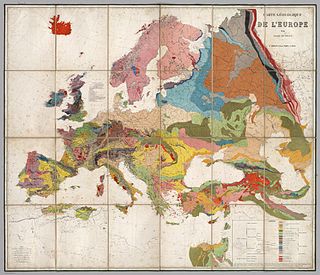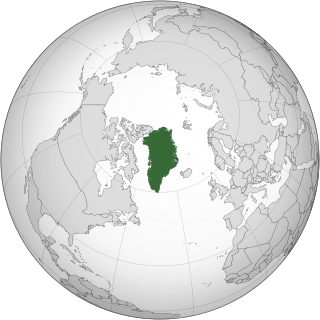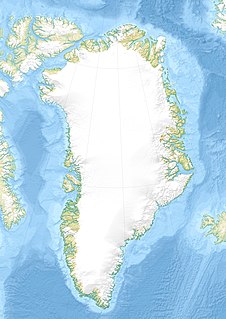History
The commission was established in 1878 by initiative of the professor of geology Frederik Johnstrup. He argued that the State of Denmark should spend some of the considerable income from kryolite mining concessions on furthering mineralogical and other research actitivities in Greenland. In the very year of foundation, the commission funded an expedition led by J. A. D. Jensen to explore the inland icecap and the nunataks now named for J. A. D. Jensen. From 1879 to 1920, its official name was the Commission for Leading Geological and Geographical Investigations in Greenland (Commissionen for Ledelsen af de geologiske og geographiske Undersøgelser i Grønland).

Geology is an earth science concerned with the solid Earth, the rocks of which it is composed, and the processes by which they change over time. Geology can also refer to the study of the solid features of any terrestrial planet or natural satellite such as Mars or the Moon. Modern geology significantly overlaps all other earth sciences, including hydrology and the atmospheric sciences, and so is treated as one major aspect of integrated earth system science and planetary science.

Professor Johannes Frederik Johnstrup was a Danish geologist and paleontologist. He was the founder of Meddelelser om Grønland.

Mineralogy is a subject of geology specializing in the scientific study of the chemistry, crystal structure, and physical properties of minerals and mineralized artifacts. Specific studies within mineralogy include the processes of mineral origin and formation, classification of minerals, their geographical distribution, as well as their utilization.
During the 1930s through the 1950s, the geologist Lauge Koch had a very strong influence on the commission's work. Because all research activity in Greenland from 1878 onwards have been recorded by the commission, its archives are extremely valuable to research in the history of Arctic exploration.

Lauge Koch was a Danish geologist and Arctic explorer.

Arctic exploration is the physical exploration of the Arctic region of the Earth. It refers to the historical period during which mankind has explored the region north of the Arctic Circle. Historical records suggest that humankind have explored the northern extremes since 325 BC, when the ancient Greek sailor Pytheas reached a frozen sea while attempting to find a source of the metal tin. Dangerous oceans and poor weather conditions often fetter explorers attempting to reach polar regions and journeying through these perils by sight, boat, and foot has proven difficult.
This page is based on this
Wikipedia article Text is available under the
CC BY-SA 4.0 license; additional terms may apply.
Images, videos and audio are available under their respective licenses.

Upernavik is a small town in the Avannaata municipality in northwestern Greenland, located on a small island of the same name. With 1,055 inhabitants as of 2017, it is the thirteenth-largest town in Greenland. It contains the Upernavik Museum. It is the northern-most town in Greenland with a population of over 1,000.

The University of Greenland is Greenland's only university. It is in the capital city of Nuuk. Most courses are taught in Danish, a few in Greenlandic and classes by exchange lecturers often in English.

Gustav Frederik Holm was a Danish naval officer and Arctic explorer, born at Copenhagen.

The Greenlandic krone was a planned currency for Greenland, plans of which were abandoned in 2009. The same name is often used for currency issued during Greenland's time as a Danish colony. The name krone is derived from the Danish krone, introduced in an 1873 currency reform that replaced Danish mark and skilling.
Meddelelser om Grønland was a Danish scientific periodical issued by the Commission for Scientific Investigations in Greenland. FoundIt was established by Frederik Johnstrup and published from 1879 to 1979. Articles were written in Danish, German, English and French. Since 1979 it has been continued as MoG Bioscience, MoG Geoscience, and MoG Man & Society, all in English.
Jens Laurentius Moestue Vahl was a Danish botanist and pharmacist. He was son of the Danish-Norwegian botanist and zoologist Martin Vahl.
Jens Vahl graduated as a pharmacist in 1819 and then started studying botany and chemistry.

Lesbian, gay, bisexual, transgender (LGBT) rights in Greenland are similar to those in Denmark. Same-sex sexual activity is legal, with an equal age of consent, and there are some anti-discrimination laws protecting LGBT people. Same-sex couples have had access to registered partnerships, which provided them with nearly all of the rights provided to married opposite-sex couples from 1996 to 2016. On 1 April 2016, a law repealing the registered partnership law and allowing for same-sex marriages to be performed came into effect.
Same-sex marriage in Greenland, an autonomous country within the Kingdom of Denmark, has been legal since 1 April 2016. The territory had previously recognised registered partnerships, from 1 July 1996 until 1 April 2016.
Dr. Erik Holtved was a Danish artist, archaeologist, linguist, and ethnologist. He was the first university-trained ethnologist to study the Inughuit, the northernmost Greenlandic Inuit.

Carl Ludwig Giesecke FRSE was a German actor, librettist, polar explorer and mineralogist. In his youth he was called Johann Georg Metzler; in his later career in Ireland he was Sir Charles Lewis Giesecke.

Jens Arnold Diderich Jensen was a Danish naval officer and Arctic explorer.

Amarortalik Island is an uninhabited island in the Qaasuitsup municipality in northwestern Greenland. The name of the island means "the place of wolves" in the Greenlandic language.

The Moravian missions in Greenland were established by the Moravian Church or United Brethren and operated between 1733 and 1900. They were operated under the auspices of the Royal Danish College of Missions until its dissolution in 1859 and were finally surrendered to the Lutheran Church of Denmark in 1900. Missionaries were allocated to the region and sometimes even sent wives who had been chosen for them and approved by the drawing of lots, a form of Cleromancy.

Tobias Island is a small island off the northeastern coast of Greenland.

Skjoldungen is a large uninhabited island in the King Frederick VI Coast, southeastern Greenland. Administratively it is part of the Sermersooq municipality. The weather of the island is characterized by tundra climate.

J. A. D. Jensen Nunataks are a nunatak group in Greenland. Administratively it falls under the Sermersooq Municipality.

Naja Abelsen is a Danish-Greenlandic painter and illustrator. Much of her art is inspired by the myths and sagas of Greenland. In addition to her work as a book illustrator, she has designed 18 stamps for Post Greenland.
Doris J. Jensen, also Doris Jakobsen, is a Greenlandic politician in the Siumut or Forward party. A former member of the Danish Folketing (2011–2015), she became an elected member of the Parliament of Greenland in 2002. In April 2018, she was appointed Minister of Health and Research in the Naalakkersuisut.


















